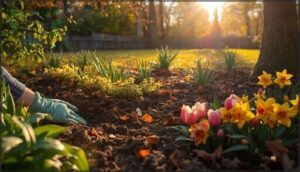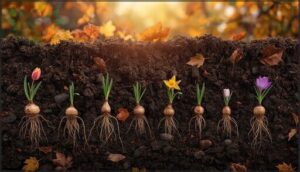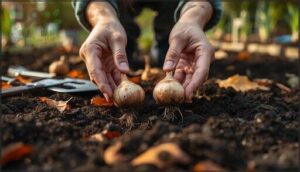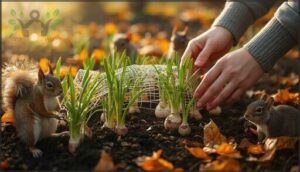This site is supported by our readers. We may earn a commission, at no cost to you, if you purchase through links.
Bulbs never ask for much—just a little patience, a patch of earth, and the secret handshake of timing. Miss that window, and you might wait a whole year for a show.
The soil sends you signals, whispering its readiness with cooling evenings and crisp, golden afternoons. Knowing when to plant fall bulbs means tuning in to nature’s quiet cues as temperatures slide and daylight slips away.
Time it right, and your garden rewards you with color that braves the last snows and lights up March. The difference between guesswork and mastery often lives in those few, cool weeks.
Table Of Contents
- Key Takeaways
- Best Time to Plant Fall Bulbs
- Planting Bulbs by Hardiness Zone
- Choosing The Right Fall Bulbs
- Buying and Storing Fall Bulbs
- Selecting The Best Planting Site
- Preparing Soil for Fall Bulbs
- Planting Depth and Spacing Guidelines
- Watering, Mulching, and Post-Planting Care
- Protecting Fall Bulbs From Pests
- Top 5 Tools and Products for Fall Bulb Planting
- Frequently Asked Questions (FAQs)
- What month do you plant fall bulbs?
- Can you plant fall bulbs too early?
- What is the rule for planting bulbs?
- Can I still plant bulbs in November?
- What bulbs should you plant in the fall?
- How to plant winter flower bulbs in the ground?
- What flowers do you plant in fall?
- Should you plant fall bulbs?
- What happens if you plant fall bulbs too early?
- What bulbs are best to plant in the fall?
- Conclusion
Key Takeaways
- Plant fall bulbs when nighttime temperatures drop to 40–50°F and the soil cools below 55°F, usually six to eight weeks before ground freeze.
- Match your planting window to your hardiness zone—earlier for colder zones, later for warmer ones—to give bulbs enough time to root before winter.
- Choose bulbs based on desired bloom time, critter resistance, and zone suitability, favoring options like daffodils and alliums for fewer pest problems.
- Check bulb quality before planting, store them in cool, ventilated containers if needed, and plant at the right depth and spacing for best spring results.
Best Time to Plant Fall Bulbs
Timing is everything when planting fall bulbs. You need to work with your garden’s natural cues and your region’s frost schedule to get it right.
Here’s what you should watch for to plant at the perfect moment.
Understanding Fall Bulb Planting Windows
When fall bulb planting season arrives, your window usually spans six to ten weeks, depending on climate impact and regional variations. Prolonged warmth can push back ideal planting time, while micro-climates may extend opportunities. Here’s what shapes your timing bulb planting success:
- Nighttime temperatures dropping to 40–50°F signal readiness
- Daytime highs staying below 70°F prevent premature sprouting
- Six weeks before ground freeze ensures proper rooting
- Delayed planting after frost still works if soil remains workable
Fall bulbs like daffodils bloom in mid-March.
Signs Your Garden is Ready
Your garden speaks when it’s ready for bulbs—you just need to listen. Soil temperature is your first clue: when nightly temperatures drop to 40–50°F and stay there, planting time begins. Environmental cues like falling leaves, overnight frost, and squirrels hoarding nuts confirm the shift. Understanding seasonal natural phenomena can further adjust your planting schedule.
Check moisture levels—soil should be damp but not waterlogged. Plant signals like perennial dieback and seed-eating birds mark the season before hard frosts and ground freezing arrive.
| Indicator | What to Look For |
|---|---|
| Soil Temperature | Consistently 55°F or lower |
| Environmental Cues | Frost, falling leaves, animal activity |
| Moisture Levels | Damp soil without puddling |
| Plant Signals | Perennial dieback, shrub buds forming |
Aligning Planting With First Frost Dates
Once your garden shows readiness, use your local first frost date as your anchor. Plant fall bulbs six to eight weeks before the ground freezing point—this window allows root development before soil conditions halt growth.
Hard frosts signal urgency, but soil temperature matters more than air temp. Regional adjustments are key: climate zones dictate whether you plant in September or December, directly affecting bloom impacts next spring.
Planting Bulbs by Hardiness Zone
Your hardiness zone acts like a roadmap for when to get those bulbs in the ground. The colder your zone, the earlier you’ll need to plant before the soil freezes solid.
Let’s break down the timing for zones 3 through 9 so you know exactly when to grab your trowel.
Zone 3 & 4 Fall Planting Schedule
In cold climates like Canada, your Zone 3 and Zone 4 gardens demand perfect timing. You’ll balance early planting risks against late planting risks, while snow cover impact and zone 3 microclimates add complexity. Here’s your planting schedule for bulbs in Zone 3 4:
- Plant from late September through early November, before ground freezes
- Watch for nighttime temperatures dropping to 32°F
- Complete planting when soil reaches 40°F
- Allow six weeks for bulb chilling needs and root establishment
- Avoid early planting to prevent premature sprouting
Zone 5-6 Timing Guidelines
Your planting window in Zones 5 and 6 stretches from mid-October through late November, when soil temperature drops below 55°F. This frost schedule gives your bulb varieties six weeks for root development before hard freezes arrive.
You’ll work in cool weather with daytime temperatures between 40°F and 50°F, ideal conditions for planting bulbs in fall across these garden zones.
Zone 7-9 Recommendations
In Zones 7 through 9, you’ll plant from late November into December, after soil temperatures settle between 40°F and 50°F. Milder winters mean pre-chilling needs for traditional bulbs, or you can choose warm-climate bulbs instead:
- Pre-chill cold-requiring bulbs for 6-10 weeks
- Select bearded irises and alliums for reliable blooms
- Monitor soil temperature with a thermometer
- Plant by December’s end in Zone 9
- Take advantage of the longer season for root growth
Choosing The Right Fall Bulbs
Not all bulbs are created equal, and your choice depends on when you want those blooms to show up. You’ll need to know which bulbs flower in spring versus summer, which ones critters will leave alone, and how to plan for a garden that keeps giving color from March through June.
Let’s break down what to look for when you’re making your selections.
Spring-Flowering Vs. Summer-Flowering Bulbs
Understanding bulb types makes all the difference in your garden’s success. Spring bulbs—tulips, daffodils, crocuses—go into the ground during fall and reward you with blooms from February through May. Summer-flowering types like dahlias and lilies get planted after the last frost for June-September color. Each category demands specific planting depth, hardiness zones, and maintenance needs that directly impact bulb longevity and bloom time.
| Feature | Spring-Flowering Bulbs | Summer-Flowering Bulbs |
|---|---|---|
| Planting Season | Fall (6 weeks before ground freezes) | Spring (after last frost) |
| Bloom Period | February–May | June–September |
| Hardiness | Zones 3–8, winter-hardy | Zones 8–11, tender varieties need lifting |
| Planting Depth | 4–8 inches deep | 2–6 inches deep |
| Longevity | Daffodils last 10+ years; tulips 3–5 years | Many require annual digging and storage |
Deer- and Critter-Resistant Varieties
Your spring garden doesn’t have to be a buffet for deer and rodents. Certain fall bulbs produce toxic biochemicals—like the alkaloids in daffodils or sulfur compounds in alliums—that make them naturally unappetizing to wildlife.
To get the most critter resistance when planting bulbs:
- Choose daffodils and alliums for near-total protection from deer and squirrels
- Add hyacinths for calcium oxalate content that deters browsing
- Plant fritillaria and snowdrops in vulnerable spots
- Combine resistant bulb varieties with physical barriers or scent repellents in high-pressure areas
These deer- and critter-resistant varieties let you enjoy spring color without constant battle against garden pests.
Selecting for Bloom Sequence and Color
Succession planting transforms flower beds from one-week wonders into months-long spectacles. You’ll want early bloomers like crocuses in March, daffodils mid-spring, and alliums extending into June—creating layered planting that delivers continuous visual impact.
Consider bloom timing alongside color palettes: fewer bulb varieties in larger drifts outperform scattered singles. Coordinate complementary hues across your spring bloomers for fluid color progressions as different spring blooms emerge.
| Bloom Period | Recommended Bulbs |
|---|---|
| Early March | Snowdrops, Crocuses |
| April | Hyacinths, Early Daffodils |
| Late April-May | Tulips, Mid-Late Daffodils |
| May-June | Alliums, Fritillaria |
| Color Planning | Mix 3-5 complementary shades |
Buying and Storing Fall Bulbs
Getting your hands on quality bulbs at the right time makes all the difference between a lackluster spring and a garden that stops people in their tracks. You’ll need to know when to buy, what to look for, and how to keep them fresh until planting day.
Here’s what you need to master the buying and storing process.
When to Order or Purchase Bulbs
The best fall bulbs disappear fast. Peak ordering happens in September and October, with most varieties selling out by mid-October. Late purchasing after October 15 reduces your choices by 40%.
Here’s how to secure your favorites:
- Order by late August or early September to access the full selection before variety trends shift inventory.
- Watch shipping deadlines — most nurseries stop taking orders by December 1 for zones 3A–5B.
- Consider climate impacts when buying fall bulbs in Canada or warm regions, ordering earlier for proper chilling time.
How to Assess Bulb Quality
Once you’ve timed your bulb purchasing right, quality checking begins. Healthy true bulbs feel firm and heavy for their size, signaling dense nutrient stores.
Inspect skin condition for mold, soft spots, or black discoloration—disease signs that spread quickly. Commercial grading practices sort by weight assessment and circumference, but your squeeze test works just as well. Skip any bulbs that feel spongy or smell off.
Proper Storage Methods Before Planting
After checking quality, proper bulb storage methods protect your investment. Store bulbs between 40°F and 65°F in breathable containers—paper bags or mesh work best. Humidity levels should stay around 70-80% with good ventilation to prevent mold during dormancy.
Dry bulbs for one week after purchase before storage. Bulb health depends on temperature control and air circulation. Storage duration shouldn’t exceed four months before planting.
Selecting The Best Planting Site
Choosing the right spot can make or break your bulb success. You need to think beyond just picking an open patch of dirt.
Let’s walk through the three key factors that determine whether your bulbs will thrive or struggle come spring.
Sunlight Requirements for Fall Bulbs
Your fall bulbs need at least six hours of direct sunlight daily for best sun hours and bloom quality. Tulips and hyacinths perform best in full sun, while crocuses and daffodils show greater shade tolerance with four to six hours. Sunlight requirements directly impact photosynthesis and energy storage.
Consider regional variations—bulbs under deciduous trees capture early spring light before canopy development, making planting site selection critical for long-term success.
Assessing Drainage and Soil Conditions
Once you’ve looked at sun exposure, turn attention to soil conditions for bulbs. Drainage testing is easy: fill a planting hole with water and see how fast it disappears. Slow drainage signals clay—fix this by amending clay with coarse sand and plenty of organic matter.
Aim for well-drained soil, balanced soil texture, and a neutral soil pH for best growth.
Avoiding Common Site Mistakes
Even if you’re keen to get bulbs in the ground, skipping key steps can haunt your garden. Depth errors—planting too deep or shallow—lead to fewer blooms or bulb rot. Shaded areas drastically reduce flowering, while compacted soil stunts root growth. Neglecting mulch dries the soil.
Choosing a planting location with well-drained soil conditions, correct spacing, and quality bulbs sets you up for success.
Preparing Soil for Fall Bulbs
Getting your soil ready is the first step toward healthy spring blooms. There are a few things you’ll want to take care of before you plant your bulbs.
Here’s what you should focus on next.
Removing Weeds and Amending Soil
Think of weeds as silent thieves—robbing bulbs of nutrients and water before they ever break ground. Rely on steady weed removal methods like hand-pulling or spade work to keep problem roots out.
While preparing your garden bed, blend in compost or peat to improve soil structure, drainage, and pH balance. Sound soil preparation puts fall bulbs on track for strong spring growth.
Adding Compost and Organic Matter
With careful soil preparation, adding compost at recommended rates transforms your planting site. Well-decomposed, plant-based compost—applied up to two inches deep—improves drainage and fuels bulbs with nutrients they need. Aim for 3–4% organic matter in your beds. Choose compost over animal manure for fall bulbs and enjoy these benefits:
- Encourages root growth
- Stabilizes soil structure
- Boosts nutrient availability
- Enhances disease resistance
- Promotes vigorous flowering
Using Soil Thermometers for Accuracy
Reading accuracy matters when planting bulbs in fall—soil thermometers remove guesswork. Insert your probe at ideal depth, four to six inches down, where bulbs will root. Check temperature stability each morning to confirm soil has cooled to 50–55°F.
This precision aids disease prevention by reducing early sprouting and rot. Choose equipment durability with stainless steel probes for the best time to plant bulbs and reliable soil preparation for bulbs.
Planting Depth and Spacing Guidelines
Getting the depth and spacing right makes all the difference when you plant fall bulbs. If you go too shallow or too deep, your bulbs won’t perform the way you expect.
Here’s how to position and space your bulbs for strong roots and beautiful blooms.
How Deep to Plant Different Bulbs
Planting depth isn’t guesswork—it’s a matter of matching bulb size to soil depth for strong roots and healthy blooms. The standard rule is to plant bulbs three to four times their height, measured from the bulb’s base to the soil surface.
- Tulips and daffodils: 6 to 8 inches deep for most standard varieties
- Hyacinths: 4 to 6 inches, adjusted for your climate zone
- Crocus and small bulbs: 2 to 3 inches deep
Proper planting depth prevents heaving during freeze-thaw cycles and improves bloom quality.
Spacing Bulbs for Optimal Growth
Spacing determines how your bulbs compete for water, nutrients, and light—and influences disease risk reduction. Large bulbs like tulips need six inches between them, while small varieties like crocus thrive at three inches apart.
Proper bulb spacing and depth work together: crowded bulbs invite fungal issues and trigger earlier bulb division timing.
For naturalized landscapes, aim for three to five bulbs per square foot, balancing landscape design impact with long-term health.
Pointing Bulbs in The Right Direction
Once you’ve nailed bulb spacing and depth, orientation matters—but won’t make or break your garden. Point the sharper end up and the flatter basal plate down for fastest emergence.
If you can’t tell which end is which, plant bulbs sideways; gravitropism effects will guide shoots upward naturally. Wrong orientation may delay sprouting five to ten days, but root development still occurs from the basal plate.
Watering, Mulching, and Post-Planting Care
Once your bulbs are in the ground, your work isn’t quite finished. A few simple steps right after planting can make the difference between a striking spring display and a disappointing one.
Here’s what you need to do to give your bulbs the best start possible.
Initial Watering Needs
After planting, water the site deeply to settle soil around each bulb and jump-start root growth. You’ll want moisture to reach six to eight inches down, where roots form.
In most cases, fall rains handle the rest if you have well-drained soil. Check soil drainage and avoid overwatering, which invites rot.
Expert recommendations emphasize one thorough soak, then relying on natural fall moisture for best timing and healthy spring blooms.
Best Mulch Types for Bulb Beds
Once you’ve watered, apply a two- to four-inch layer of mulch for moisture control and temperature stability. Organic mulches work best for bulb beds:
- Wood chips or shredded bark enrich soil as they break down
- Straw mulch suppresses weeds and decomposes quickly
- Pine needles suit acid-loving varieties
- Compost adds nutrients directly
- Shredded leaves trap air in cold weather
Inorganic options like gravel drain well but skip soil benefits. Regional factors matter—lighter mulches help hot climates, thicker layers protect northern zones during freeze-thaw cycles.
Protecting Bulbs During Winter
Mulch does more than lock in moisture—it’s your first line of winter protection. Snow cover acts as a natural insulator, cutting frost penetration by 30% in cold climates. Frost protection improves when you add straw mulch or evergreen boughs over bulb beds. Bulb insulation matters most during freeze-thaw cycles that damage roots.
| Protection Method | Best For | Key Benefit |
|---|---|---|
| Snow cover | Cold-climate zones | Reduces freeze depth naturally |
| Straw mulch layers | Zones 3–6 | Traps air, prevents heaving |
| Rodent deterrents | All zones | Blocks vole and squirrel damage |
Cold weather invites critters. Coat bulbs with chili powder or use wire mesh baskets to stop rodents from targeting your tulips and crocuses during dormancy. Physical barriers reduce winter losses to nearly zero.
Protecting Fall Bulbs From Pests
Keeping your fall bulbs safe from hungry critters is just as important as getting them in the ground at the right time. Squirrels, voles, and other pests can quickly undo your hard work if you aren’t careful.
Here’s what you can use to protect your bulbs before the damage starts.
Deterring Squirrels and Voles
Ever noticed how squirrels can sniff out bulbs quicker than a bloodhound? Physical barriers like chicken wire keep garden pests and diseases at bay.
For better pest management for bulbs, plant resistant bulbs deep under mulch, use gravel or crushed shells, and regularly monitor maintenance. Organic deterrents and consistent planting depth help foil even crafty voles in your garden.
Using Natural and Commercial Repellents
With garden pests and diseases threatening bulbs, your pest management for bulbs often relies on natural repellents and commercial options. For organic gardening, essential oils, mint herbs, or coffee grounds all deter critters safely.
Commercial effectiveness depends on reapplication and careful label reading. Vary your application methods, and weigh safety concerns, blending integrated strategies for the most reliable pest control—beyond just chicken wire.
Fencing and Physical Barriers
After years of planting bulbs in Zone 3 and 4, I’ve found physical barriers outperform sprays alone. To keep voles at bay when planting flower bulbs in fall, consider:
- Mesh size: 1/4 inch or less blocks rodents
- Installation depth: 12–24 inches underground works best
- Material types: Choose hardware cloth or galvanized chicken wire
- Barrier maintenance: Inspect for gaps and rust regularly
Solid pest control relies on smart, proactive choices—even in challenging climates like Canada. Cost analysis favors barriers for small beds, where losses hurt most.
Top 5 Tools and Products for Fall Bulb Planting
Having the right tools on hand makes fall bulb planting less of a headache and much more rewarding. Here are a few essentials I always keep close by each season.
Let’s take a look at five tried-and-true favorites that help set your bulbs up for success.
1. AcuRite Stainless Steel Soil Thermometer
Ever wrestled with doubts over soil temperature before planting bulbs? The AcuRite Stainless Steel Soil Thermometer brings accuracy right into your hands. Its analog display is easy to read, and the 7-inch probe checks planting depth with precision every fall.
Calibrating for accuracy is straightforward, but be mindful: some users note durability concerns if dropped. Rely on this tool for soil monitoring—knowing correct timing can turn an ordinary bulb-planting guide into real results, season after season.
2. Espoma Organic Bulb Tone Plant Food
You want blooms that stand out next spring? Espoma Organic Bulb Tone brings science and sustainability into your fall planting routine.
With an NPK Ratio of 3-5-3 and Bio-tone Microbes, this plant food feeds bulbs slowly and safely, encouraging strong roots and vivid flowers. It’s designed for organic gardening, leaving out synthetic fillers for a cleaner environmental impact.
Stick to recommended application rates, sprinkling directly in the planting hole—fertilizing bulbs this way means healthier beds and more reliable, colorful results every year.
3. Natural Animal Repellent Spray Protector
Spray effectiveness matters, especially in bulb planting season when critters are hungry and hope to dig up your hard work. A natural repellent spray, rich in key ingredients like putrescent egg solids and essential oils, deters deer, rabbits, and more while minimizing risks to pollinators. For consistent results, apply every three days at first, then shift to a monthly routine as pressure decreases.
Planting flower bulbs in the fall? This bulb planting guide wouldn’t be complete without considering safety and smart market trends.
4. Safer Brand Deer Rabbit Repellent
Safer Brand Deer Rabbit Repellent stands out for protecting bulbs in Zone 3 and beyond, using repellent ingredients like putrescent eggs, capsaicin, and garlic. Application methods are simple: spray leaves, stems, and beds until wet. It’s weather resistant, but you’ll want to reapply after heavy rain for best results.
Keep safety concerns in mind—avoid edible crops due to egg allergens. Customer reviews praise its performance with planting bulbs, especially in areas where deer or rabbits challenge every effort to plant fall bulbs securely.
5. The Vegetable Gardening Book by Lamp’l
After bolstering your bulbs’ defenses, focus shifts to growing a resilient garden, and that’s where The Vegetable Gardening Book by Lamp’l shines. The book covers soil health, garden design, and pest management with clear, actionable strategies.
You’ll find practical planting guides for bulbs in Canada or warmer zones, plus crop profiles and bulb planting tips that mesh with organic gardening.
For anyone looking to plant fall bulbs and get the most out of every inch, it acts as an easy-to-navigate reference year after year.
Frequently Asked Questions (FAQs)
What month do you plant fall bulbs?
Dig in when nature drops a hint: for most US Planting Regions, planting flower bulbs begins in October.
Watch for daytime temperatures dipping below 60°F and aim for planting bulbs 2–4 weeks before your local first frost date.
Can you plant fall bulbs too early?
If you plant fall bulbs too early, they can start growing before cold sets in, risking premature sprouting, poor root development, more disease risks, and missed chilling needs, all of which can limit bloom performance next spring.
What is the rule for planting bulbs?
Think of bulbs as buried treasure—hidden beneath the soil, their future bloom depends on proper bulb depth and spacing, the pointy end up (orientation matters), good soil drainage, and sunlight needs.
That’s the root of bulb planting.
Can I still plant bulbs in November?
You can still have November planting success with many flower bulbs, especially with late-season varieties. Regional temperature impact matters—chilly soils in Zone 3 or Canada need timely planting.
Focus on soil preparation tips and post-planting protection for strong blooms.
What bulbs should you plant in the fall?
Some flower bulbs you shouldn’t overlook in fall are daffodils, hyacinths, tulips, crocus, and alliums for spring bloomers. Colchicum and Lycoris are hardy bulbs for fall bloomers.
Favor deer resistance, bloom sequence, and hardiness zones.
How to plant winter flower bulbs in the ground?
Start by loosening soil to reduce compaction, then add compost for nutrients.
Place bulbs with the pointed end upward for correct bulb orientation. Follow the specific planting depth and spacing chart, mulch well, and consider winter protection strategies.
What flowers do you plant in fall?
Surprisingly, fall’s planting window welcomes more than just tulips and daffodils. You can tuck in spring bloomers, hardy bulbs like crocus, classic daffodils, unique varieties, and even fall annuals—suited to your zone considerations and perennial choices.
Should you plant fall bulbs?
Planting fall bulbs is a smart move for reliable spring color with little effort. The reward is vibrant blooms, increased garden biodiversity, and low-maintenance beauty.
Choose pest-resistant varieties for lasting results—especially important when planting bulbs in Canada or Zone
What happens if you plant fall bulbs too early?
When you plant bulbs too early, warm soil can trigger premature sprouting. That quick start leaves shoots vulnerable to frost damage, encourages poor roots, delays blooms, and may even lead to bulb rot instead of healthy spring growth.
What bulbs are best to plant in the fall?
You might say fall’s hush is a secret invitation—prime for nestling in hardy bulbs.
Spring bloomers like daffodils, tulips, hyacinths, and allium thrive now, offering regional hardiness, critter resistance, and a tapestry of bloom sequence.
Conclusion
Start your bulbs off on the right foot and you’ll step into spring with confidence. When to plant fall bulbs isn’t a guessing game—it’s a skill shaped by climate, timing, and close observations.
Watch the soil, trust your thermometer, and make each planting deliberate. Season after season, you’ll see how the smallest preparations can bloom into the brightest results.
Mastering this timing transforms uncertainty into results that rise right on cue, year after year.














